Illinois is home to over 60 species of mammals and 450 species of birds in the wild.
However, these mammals and birds are a minor fraction of the total amount of animals in the state.
Reptiles, amphibians, fishes, insects, and other invertebrates make up the lion’s share of Illinois wildlife.
Some creatures like cougars, bison, snakes, and venomous insects are among the most dangerous animals in Illinois. You must be aware of these deadly creatures, bearing in mind the consequence of messing around with them.
Please beware of the following wild animals as you visit the Driftless Area, Shawnee National Forest, Crab Orchard, Emiquon, Hackmatack, Meredosia, or other wildlife refuges within the state.
Here are the top ten deadliest animals in the state of Illinois.
What are the Most Dangerous Animals in Illinois?
1. Timber Rattlesnake
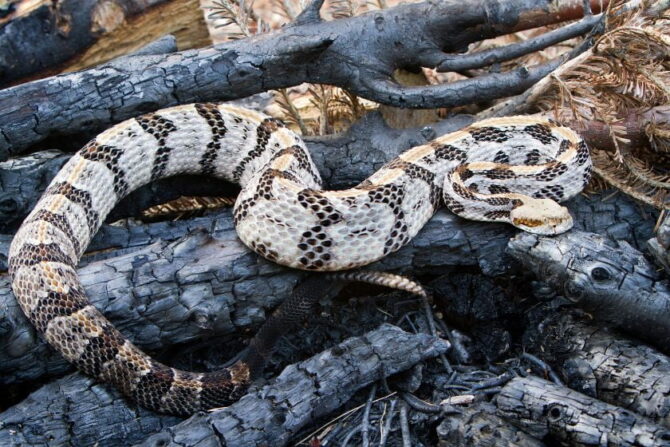
- Scientific Name: Crotalus horridus
- Classification: Reptile
- Habitat: Mountainous forests, hilly forests, agricultural fields, hardwood forests, lowland cane thickets, pine forests, swamps, river floodplains
- Primary Diet: Carnivore
- Conservation Status: Least Concern
Timber rattlesnakes can grow up to five feet, but do not be surprised if you find one in Illinois roughly seven feet long.
These venomous pit vipers do not prey on humans but rodents, birds, lizards, and amphibians.
We must warn you about the timber rattlesnake if you plan to hike through Illinois’s forest trails, especially in Southern Illinois. However, they would not aggressively act if you do not try to disturb them.
The timber rattlesnake is highly venomous, with an extremely potent, hemotoxic venom enough to kill a human.
Therefore, a victim should still consider this rattlesnake’s bite dangerous and seek medical help immediately.
2. Brown Recluse Spider

- Scientific Name: Loxosceles reclusa
- Classification: Arachnid
- Habitat: Debris, woodpiles
- Primary Diet: Carnivore
- Conservation Status: Not Extinct
The Illinois Department of Public Health estimates over 500 spider species in the state, and the brown recluse spider is among them.
This spider is among the United States’ most poisonous house spider species, despite not growing over a quarter or half an inch long.
You can find them anywhere, including houses, schools, sheds, and barns, and you must be on the lookout if you live in Southern Illinois.
The brown recluse spider is venomous, with about ten percent of brown recluse bites causing moderate or more significant tissue damage and scarring.
Severe symptoms result in a necrotic lesion where the venom begins to destroy the surrounding tissues, and the wound may expand several inches over the next few days or weeks.
However, there are no verified fatality cases from a brown recluse spider.
According to reports, the brown recluse spider’s bite can cause systemic loxoscelism in extreme cases. Systemic loxoscelism is a severe illness involving blood clotting disorder and red blood cell destruction.
Sadly, the United States has not approved any effective commercial anti-venom for the brown recluse spider’s bite.
3. Black Widow Spider

- Scientific Name: Latrodectus
- Classification: Arachnid
- Habitat: crevices, hollow logs, loose bark, holes, burrows, small trees, bushes, woodpiles
- Primary Diet: Carnivore
- Conservation Status: No special status
The black widow spider is not often aggressive and stings people in an attempt to defend itself.
However, the black widow spider is one of the thirty to thirty-five species of spiders you may ‘regularly’ see in the southern-half parts of Illinois.
Their red, hourglass-shaped mark can be pretty attractive, but it is wise to admire them from a distance.
We hope this helps if you have started developing arachnophobia after reading the previous paragraph on the brown recluse spider.
The black widow spider’s bite is often felt like a pin-prick, but the consequences have more negative impacts.
Their venom is neurotoxic, causing chest pain, muscle aches, nausea, muscle tightness, cramping, and a paralysis of the diaphragm, making breathing difficult.
Bites can be fatal but uncommon as only children, the elderly, or the infirm suffer from complications.
4. Cougars
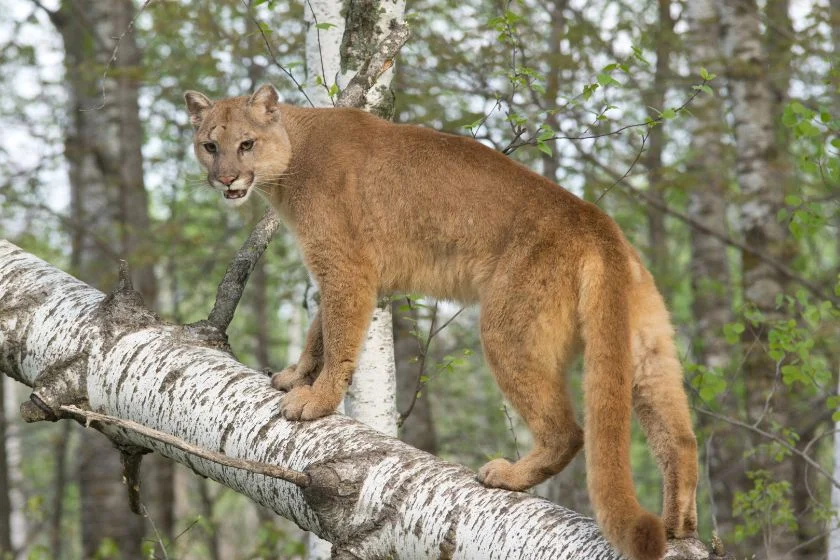
- Scientific Name: Puma concolor
- Classification: Mammal
- Habitat: Steep, rocky canyons, coastal forests, deserts, mountainous terrain
- Diet: Carnivore
- Conservation Status: Least Concern
Cougars might be the smallest of the large cats, but they are silent hunters that stalk potential prey before attacking, thanks to their excellent senses, their ability to hide, and use fur as camouflage.
These wild cat species do not prey on humans but may attack if cornered or a fleeing human stimulates their instinct to chase.
Food shortage or territory loss could also trigger their hunting instincts if they meet a human in the wild, resulting in injuries or death as a cougar’s 400 PSI bite force can kill a human.
Reports indicate multiple cougars, black bears, and wolf sightings even though cougars have no breeding populations in Illinois.
Therefore, running into a cougar in the wild is possible, and it would be a decent idea to give these large cats a wide berth.
5. Striped Bark Scorpion
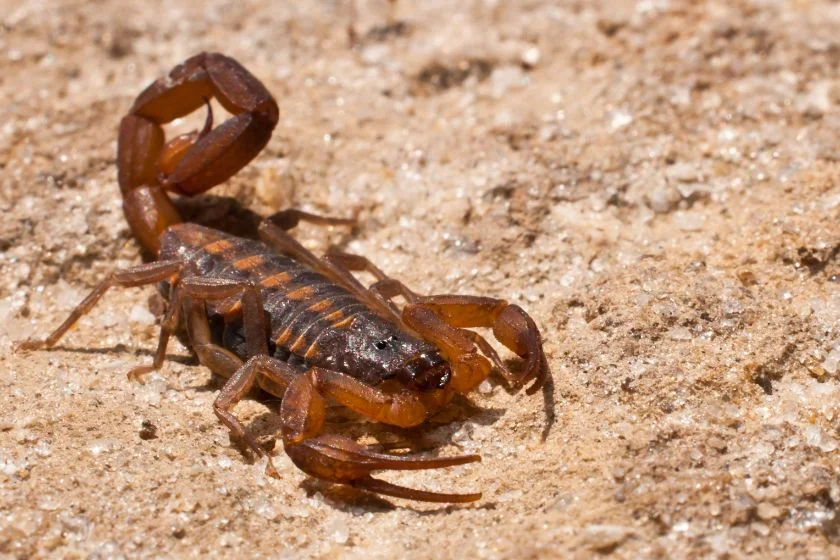
- Scientific Name: Centruroides vittatus
- Classification: Arachnid
- Habitat: Rock piles, logs, dense vegetation
- Primary Diet: Carnivores
- Conservation Status: Least Concern
The striped bark scorpion is Illinois’s only scorpion of the world’s 1,400-plus species.
It is common in the state’s Southwestern areas; however, you rarely tend to find these scorpions, thanks to their reclusive and nocturnal habit.
Before moving too close to admire the striped bark scorpion’s blue-green glowing beauty, remember that it has a painful and potentially dangerous sting, especially for people allergic to its neurotoxic venom.
Illinois’s long, warm, humid, and wet summers provide ideal conditions for the striped bark scorpion that seeks out cool spots in large rocks and piles of wood debris.
It would be wise to tread carefully or avoid these areas to prevent an encounter with one of the state’s most dangerous creatures.
A striped bark scorpion’s venom could lead to swelling, inflammation, and pain, lasting several days.
6. Massasauga
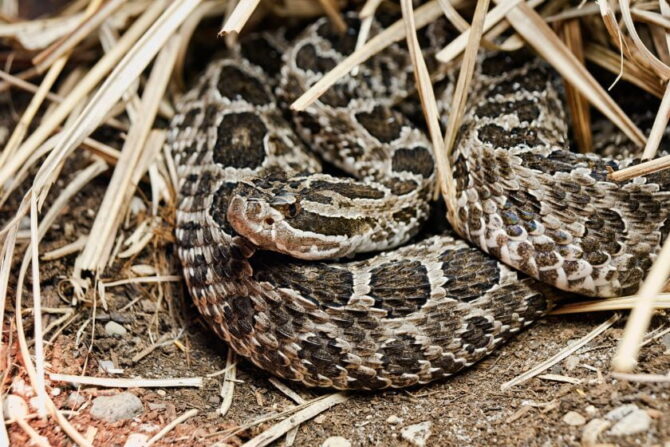
- Scientific Name: Sistrurus catenatus
- Classification: Reptile
- Habitat: Wetlands, prairies, swamps, woodlands, tree roots, rock crevices
- Primary Diet: Carnivore
- Conservation Status: Least Concern
Everyone knows better than to provoke a rattlesnake, and rattlesnakes mind their matters without provocation.
The Massasauga is one of the four rattlesnake species you can find in Illinois, scattered across the state’s northern two-thirds.
Like other rattlesnakes, the Massasauga is timid, tending to hide wooden debris or vegetation in the wild.
While you might be intrigued by Massasauga’s brown blotches on the gray ground and keeled scales, its venom is very toxic.
Fortunately, there are very few fatality records from the Massasauga’s bites; its teeth are too small to inject enough venom for terrible harm.
Nevertheless, a victim should still consider a Massasauga’s bite dangerous and seek medical help immediately.
7. Copperhead
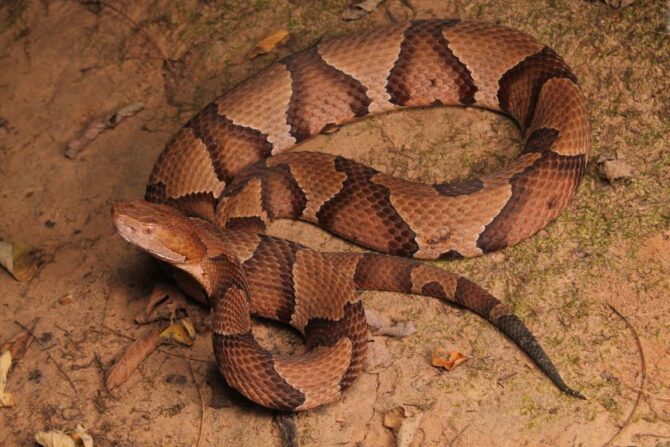
- Scientific Name: Agkistrodon contortrix
- Classification: Reptile
- Habitat: Deciduous forests, mixed woodlands, rock outcroppings, ledges, swampy regions, dens, limestone crevices
- Primary Diet: Carnivore
- Conservation Status: Least Concern
You will most likely fall in love with the Copperhead at first sight if you are a lover of snakes.
Its bronze-hued head, reddish-tan, copper-colored body (where it undoubtedly gets its name from), and hourglass-shaped stripes on its back are so hard to ignore.
Nevertheless, the Copperhead’s artful appearance should not be translated as beckoning.
The Copperhead ejects a hemolytic venom that breaks down red blood cells.
Its estimated dose is around 100 milligrams, amongst the least potent pit vipers, but its bites can be severe, resulting in nausea, vomiting, diarrhea, or labored breathing.
You will find this dangerous snake species around southern one-third of Illinois and in the lower Illinois River valley.
8. Bison
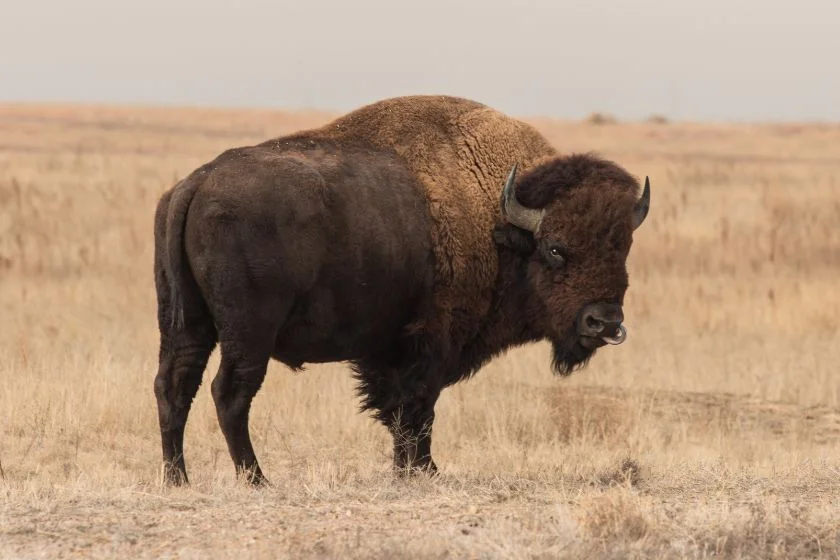
- Scientific Name: Bos bison
- Classification: Mammal
- Habitat: North America’s grasslands and open savannas
- Primary Diet: Herbivore
- Conservation Status: Near Threatened
The International Union for Conservation of Nature (IUCN) places the bison in the “Near Threatened” red list category; therefore, it feels nice that a few bison herds have returned to Illinois after almost two hundred years.
They are intimidating and irritable, with brute strength, speed, and rock-solid horns; little wonder they are revered as North America’s largest mammals.
A male bison (bull) can weigh up to 2,000 pounds and reach six feet in height.
Impressively, a bison can outrun a horse for a quarter mile and jump up to six feet vertically.
Bison are deadly threats when provoked; they are confident and would waste no time aggressively reacting when they sense danger around calves, feel harassed, or threatened.
Many human activities seem threatening to bison and could prompt their defensive instincts to charge at a human without warning.
Illinois Wildlife Safety Tips
The following tips will help you stay safe as you interact with or encounter wildlife in Prairie State.
Stick to high visibility areas
Watching animals in their natural habitats go about their usual wildlife business is soothing. However, venturing into the wild could be very risky.
Hikers are encouraged to stick to trails, avoiding grasses and overgrown places where snakes and other species can hide.
Understand what species are located in the area
Some species are more common in some parts of the state than in other areas due to climate or landscape.
Knowing what species are located in the area can help you peculiarly prepare for an encounter with these animals.
For instance, you could avoid dense vegetation, especially in the southern half of Illinois.
Watch wildlife from a safe distance
It will be best never to follow or approach wild animals due to their unpredictability and defensive instincts.
Wildlife may quickly feel concerned or threatened and, in their defense, harm people or themselves in an attempt to escape.
Animals like bison are irritable and feel threatened by many human activities.
A wise course of action will be to slowly back away if a bison starts focusing on you, as such an action could indicate that you are too close.
Wrap Up
The United States’ third largest city, Chicago, is in Illinois.
The state has the country’s fifth-largest Gross Domestic Product (GDP) and the sixth-largest population.
However, it is rich in wildlife and is home to several species.
Please be cautious of these most dangerous animals in Illinois as you explore nature’s breathtaking views and the freedom of wildlife.






